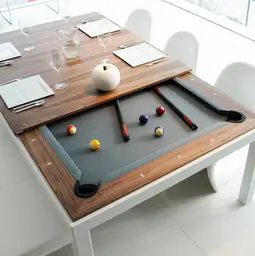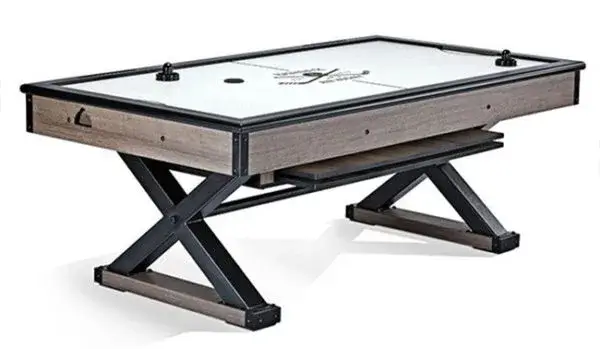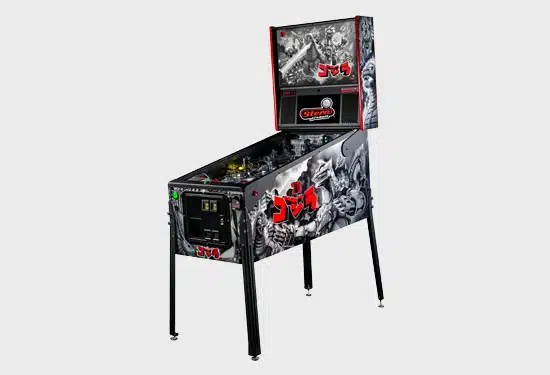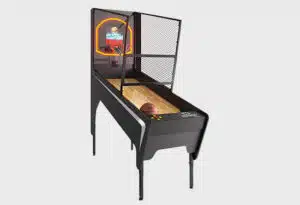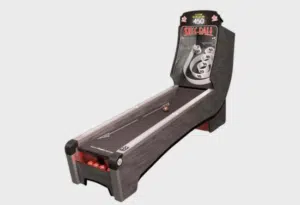Sometimes all you want to know are the basic rules to play a friendly match of ping pong. In singles, the center lines serve no purpose, so ignore them.
Scoring
A match is played best 3 of 5 games (or 4/7 or 5/9). For each game, the first player to reach 11 points wins that game, however a game must be won by at least a two point margin.
A point is scored after each ball is put into play (not just when the server wins the point as in volleyball).
The edges of the table are part of the legal table surface, but not the sides.
Flow of the Match
Each player serves two points in a row and then switch server. However, if a score of 10-10 is reached in any game, then each server serves only one point and then the server is switched. After each game, the players switch side of the table. In the final game (ie 5th game), the players switch side again after either player reaches 5 points.<
Legal Service
The ball must rest on an open hand palm. Then it must be tossed up at least 6 inches and struck so the ball first bounces on the server’s side and then the opponent’s side.
If the serve is legal except that it touches the net, it is called a let serve. Let serves are not scored and are reserved.
Equipment
The paddle should have a red and a black side. The ball should be either orange or white and 40 mm in size. The table should be 2.74 meters long, 1.525 m wide, and 0.76 m high.
Deciding Who Serves First
According to the official International Table Tennis Federation (ITTF) rules, the right to choose whether to serve first is determined “by lot” (i.e. flipping a coin or drawing straws, etc.), with the winner choosing either whether to serve first or which side he or she wants. If the winner chooses whether to serve or to receive, the opposing player or team gets to choose which side of the table they will play on, and vice versa. In most recreational ping-pong games, however, the serve is determined by a quick rally, typically with each player spelling out one letter of the word P-I-N-G for each hit they make. After the word P-I-N-G is spelled out, the person to win the rally serves first or chooses which side of the table they wish to play on.
Serving The Ball
The ball should be tossed out of your free hand vertically a minimum of 16cm, and then hit with the paddle so that it first hits your side of the table once and then goes over the net and hits your opponent’s side. If playing singles, the server can serve to any point on the opponent’s side of the table, and the opponent should then return it. If playing doubles, the serve is rotated between you and your partner, starting with the person on the right, and the ball must bounce first in the right half of your side of the table and then must be delivered cross-court to your opponent’s side. After two points have been awarded, your opponent or, in doubles, the person on the opposing team who is cross-court from the server, then gets to serve. After two more points are awarded, the original server’s or, in doubles, his partner, then serves. In other words, the serve switches sides every two points. If the ball hits the net on an otherwise a legal serve, the serve is a “let,” and the serve is repeated with no points scored. After 2 consecutive lets the player opposite of the server receives the point. On game point the person that is losing shall be the server.
Returning The Ball
After a serve or return, the ball may be returned over or around the net to any point on the opponent’s side of the table. The ball must be returned after it bounces once on your side, but before it bounces twice or hits the floor or any object off the table. If the ball hits the net on a return, but proceeds to go over the net and hit your opponent’s side, the ball is still in play, and your opponent must return it.
Scoring Points
A point is awarded for each rally that is not a let, and either opponent can score a point regardless of who served.
- If your serve goes into the net, goes off the table without hitting the opponent’s side, or (in doubles) hits the wrong half of the opponent’s side, the receiving opponent or team scores a point.
- If you do not make a legal return (as described above: i.e. the ball goes into the net or doesn’t hit your opponent’s side of the table) a point is awarded to your opponent.
- If you receive a legal serve or return and hit the ball more than once with your paddle or touch the ball with your body, a point is awarded to your opponent. Note that if your opponent’s serve or return doesn’t hit your side of the table, you still get the point even if the ball hits you or you catch it after it passes the end of the table.
- If you touch the table with your free hand or move the table, your opponent scores a point.
Winning The Game
Many people like to play to 21 or 15 (alternating server every 5 points), which is fine for recreational play. The official rules, however, state play is to 11 points (alternating server every 2 points). In order to win, one must be ahead by two points. If the players or teams are tied at 10-10 or 20-20, for example, the normal order of service proceeds, but the serve alternates sides after every points instead of after every two points.
Play again
In sanctioned competition, matches are won by the player or team who wins two out of three games. The players switch sides after each game, and they also switch sides in the third game (if a third game is necessary) when one player or team scores five points. The team or player serving first also changes each game.
Practice Consistently
You can become a pretty good ping-pong player quickly with consistent practice. The most important things to practice initially are keeping your eye on the ball, getting a feel for the correct timing, and keeping the ball low. From the very first time you pick up a paddle, you should consciously make an effort to follow the ball with your eyes, from the moment it is served to when it hits your paddle, and so on. Your timing will become better with practice–you just need to get used to it–but it helps if you listen to the ball as well as watch it closely. Keeping the ball low–without hitting it into the net–is probably the hardest skill for beginners to master. It’s also one of the most essential, because a high ball can easily be smashed down by your opponent. Try to keep your paddle as horizontal as possible and use your wrist to impart energy to the ball and to aim it. Generally, the faster the ball is moving, the easier it is to keep it low.
Develop A Backhand and Forehand
You must be able to hit the ball from either side of your body if you want to become good at table tennis, and it’s generally not practical to switch hands, so get comfortable with both your forehand and backhand shots.
Learn To Put Spin On The Ball
This is done by flicking the wrist side-to-side or up-and-down right as the ball is hit. To counter-spin, put spin of your own on the ball. If you don’t know how to put spin on something, politely ask an experienced player to show you how (it is easier to understand through experience rather than reading how.)
Smash balls that your opponent hits high
Smashing (also called slamming or spiking) the ball entails hitting it with force so that it goes fast enough to, hopefully, be unreturnable. A slam is a powerful weapon, but it can be difficult at first to use it accurately, and you may find that your slams initially go into the net or well off the other side of the table. Don’t be afraid to keep trying them, though. You’ll eventually get it.
Develop A Killer Serve
A fast serve or a serve with plenty of spin on it can become the key to your game as you face better players. If you give your opponent an easy serve, you’ll be lucky to get a paddle on his return.
Outmaneuver Your Opponent
As you face better competition you can’t just expect your opponent to make mistakes, even if you’re hitting the ball hard. You’ve got to force errors by taking control of the game and making your opponent move around the table a lot. If you can hit one shot off the right side and then quickly hit another shot to the left side you might be able to prevent your opponent from getting the ball. Tricks, such as giving the appearance of a slam and then dinking the ball, or getting into a right-left pattern and then hitting two or three consecutive shots to the right, can also put your opponent off-balance and in position for a slam.
Pool Tables
Outdoor & Patio
Game Room Furniture

Games
Arcade
Accessories
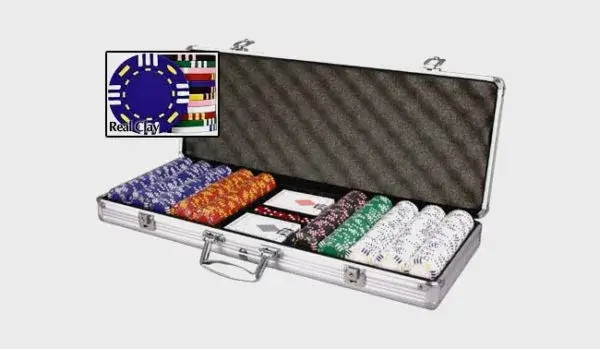
Services
Specials
